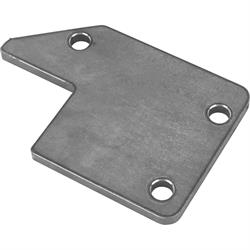Cross Steering vs. Traditional Steering
Cross Steering Cross Steering linkage is the preferred method for nearly all transverse leaf spring/beam axle suspension set-ups. Ford used it themselves from 1935-48. Cross Steering suffers far less bump steer and offers a more comfortable steering column angle. It also frees up much needed foot pedal box/bellhousing clearance and cleans up the appearance of the chassis from a side view (very important on an open wheel car). The Vega steering box is the only box to consider on Model T through 1934 Fords. Ford cars from 1935-48 can use a Vega or Saginaw 525 steering box, which gives the option of power steering for these cars.
Traditional Steering Traditional Steering linkage will only work with the following combinations: a parallel 4-bar suspension used with a 1968-73 Mustang steering box OR a split wishbone/hairpin radius rod suspension used with a reversed Corvair steering box. You can also use a 1948-56 Ford F1/F100 truck steering box with Traditional Steering. An upper steering arm allows the attachment of a drag link to the driver side spindle, which is attached to the spindle with bolts through the upper two backing-plate mounting holes.
Summary
When it comes to hot rod straight axle front suspensions, the steering linkage plays a crucial role in how the vehicle handles and performs. The choice between cross steering and traditional steering linkage depends on the specific needs and preferences for the hot rod's performance, handling characteristics, aesthetics, and ease of installation. Here are the key differences between cross steering and traditional steering linkage:
- Cross Steering Linkage
- Configuration:
- In cross steering, the steering box is typically mounted to the frame on one side (usually the driver's side) of the vehicle
- The drag link runs from the pitman arm on the steering box across to the opposite side of the vehicle, connecting to a steering arm on the passenger side
- Advantages:
- Improved Handling: Cross steering can offer better handling via reduced bump steer, as the drag link moves in a more parallel motion to the axle, helping maintain more consistent steering geometry
- Cleaner Look: The setup is often cleaner looking and less cluttered under the vehicle
- Disadvantages:
- Space Constraints: Cross steering requires more space under the car, which may cause fitment issues with engine components and exhaust systems
- Traditional Steering Linkage
- Configuration:
- Traditional steering linkage typically involves a setup where the drag link runs from the pitman arm on the steering box directly to a steering arm on the same side of the axle
- The tie rod connects the two steering arms on each side of the axle
- Advantages:
- Simplicity: This setup is straightforward and easy to install
- Widely Used: Traditional steering is a common configuration, meaning there are plenty of parts and knowledge available
- Disadvantages:
- Bump Steer: More prone to bump steer because the drag link and tie rod may move in different arcs, causing changes in steering angle as the suspension cycles
- Less Precise: Can result in less precise steering feel and performance compared to cross steering





